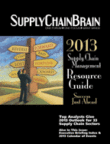
Visit Our Sponsors |
|
|
|
|
|
|
|
|
|
|
|
|
|
|
|
|
|
|
|
|
|
|
|
|
|
|
|
|
|
|
|
|
|
|
|
|
|
|

The term "Big Data" is not just an IT buzzword that supply chain folks can choose to ignore. It is becoming more and more of a reality - and valuable leveraging point - in their own organizations.
What do we mean by Big Data? There are three attributes to Big Data: Volume, Velocity and Variability. An example of volume in retail is the number of SKU Ship-To combinations - which can run into millions then translate to billions of planning relations.
An example of variability is the demand pattern shifts that happen across a set of low-volume but high-value products which becomes difficult to forecast. This is common in industrial equipment and high-technology industries. An example of velocity is the rapid addition of new products in organizations and the need to plan for those products from a demand as well as supply perspective. These three factors combined have become critical for organizations to manage as part of their S&OP process.
When companies have a basic S&OP process, it is easier for them to create the plans at a monthly level and at an aggregate level of granularity such as product families or categories (Level 1 "reacting" on the Gartner Maturity model). However, when companies mature to Level 2 "balancing" or 3 "collaborating" or 4 "orchestrating", then it is critical for them to be able to plan at a monthly level and also re-plan at ad hoc frequencies to plan at a much more granular level (SKU, ship-to or customer level). Without the nuances of big data volume, velocity and variability, they can't reliably power ad hoc decision making required by today's volatile business environments.
To meet the potential, requirements for Big Data-enabled S&OP processes include the ability to:
"¢ do volumetric and financial planning in the same environment,
"¢ do global, corporate-wide S&OP planning and reporting
"¢ plan across operational and strategic time horizons in single environment
"¢ create global supply-demand scenarios
"¢ ensure real-time integration to back end systems.
The key benefits that companies get as a result of the Big Data enabled S&OP process are:
"¢ a single unified data model for supply, demand and finance
"¢ the ability to do global scenario management across the supply, demand and finance
"¢ extremely rich collaborative capabilities.
Best yet is the business value of Big Data in S&OP. Big Data-enabled S&OP allows companies to do high-resolution planning and analytics. With inherently greater accuracy and visibility, the following metrics will get a big boost from Big Data: forecast accuracy, order to deliver lead-times, inventory levels and cash-to-cash cycle times.
The Outlook
In 2013, expect to see Big Data becoming more of an issue in supply chain management. Expect to see a convergence of planning and analytics applications which must support Big Data. Also, supply chain professionals need to become more technology savvy on Big Data related issues to be more responsive to the business requirements such as analyzing Point of Sale data, rapidly simulating the addition of new products and the impact on the overall S&OP plan.
Keywords: supply chain management, supply chain solutions, supply chain systems, integrated business planning, demand variability, demand planning, forecasting accuracy
RELATED CONTENT
RELATED VIDEOS
Timely, incisive articles delivered directly to your inbox.






